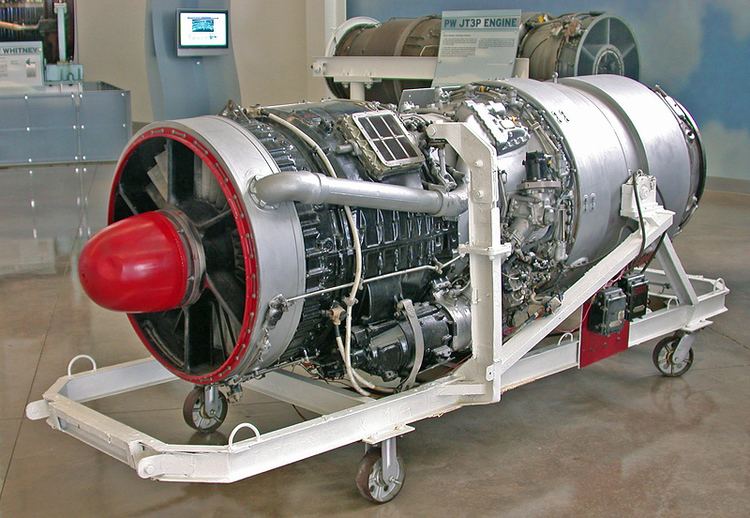 | ||
The Rolls-Royce Avon was the first axial flow jet engine designed and produced by Rolls-Royce. Intended as a jet successor to the Merlin, introduced in 1950 it went on to become one of their most successful post-World War II engine designs. It was used in a wide variety of aircraft, both military and civilian, as well as versions for stationary and maritime power.
Contents
- Design and development
- Operational history
- Variants
- Military aviation
- Civil aviation
- Other uses
- Survivors
- Engines on display
- Specifications Avon 301R
- General characteristics
- Components
- Performance
- References
An English Electric Canberra powered by two Avons made the first nonrefuelled nonstop transatlantic flight by a jet, and a BOAC de Havilland Comet 4 powered by four Avons made the first scheduled transatlantic crossing by a jet airliner.
Production of the Avon aero engine version ended after 24 years in 1974.
The current version of the Avon, the Avon 200, is an industrial gas generator that is rated at 21-22,000shp. As of 2011, 1,200 Industrial Avons have been sold, and the type has established a 60,000,000 hour record for its class.
Design and development
The engine was initially a private venture put forward for the English Electric Canberra. Originally known as the AJ.65 for Axial Jet, 6,500 lbf the engine was based on an initial project concept by Alan Arnold Griffith. which combined an axial compressor with a combustion system and single-stage turbine using principles proven in the Rolls-Royce Nene engine. The Avon design team was initially headed by Stanley Hooker until the development of the engine was moved from Barnoldswick to Derby in 1948 and Hooker subsequently left the company, moving to Bristol Engines. Design had started in 1945 and the first engine ran on March 25, 1947, with a 12-stage compressor. The engine was difficult to start, would not accelerate and broke first-stage blades. Two-position inlet guide vanes and compressor bleed were among the design changes which allowed the engine, as the RA.2, to run a 25-hour test and fly in the two outboard positions on the converted Avro Lancastrian military serial VM732, from Hucknall on August 15, 1948.
The first production engine, which needed a two-stage turbine, was the RA.3, or Avon Mk 101.
The Avon 200 series was a complete redesign with very little in common with earlier Marks. Differences included a completely new combustion section and a 15-stage compressor based on that of the Armstrong-Siddeley Sapphire. The first application was the Vickers Valiant.
Operational history
The engine entered production in 1950 as the RA.3/Mk.101 with 6,500 lbf (29 kN) thrust in the English Electric Canberra B.2. Similar versions were used in the Canberra B.6, Hawker Hunter and Supermarine Swift. Uprated versions followed, the RA.7/Mk.114 with 7,350 lbf (32,700 N) thrust in the de Havilland Comet C.2, the RA.14/Mk.201, 9,500 lbf (42 kN) in the Vickers Valiant and the RA.26, 10,000 lbf (44 kN) used in the Comet C.3 and Hawker Hunter F.6. An Avon-powered de Havilland Comet 4 flew the first scheduled transatlantic jet service in 1958. The highest thrust version was the RA.29 Mk.301/2 (RB.146) used in later versions of the English Electric Lightning. It produced 12,690 lbf (56,450 N) and 17,110 lbf (72,770 N) with afterburning. Other aircraft to use the Avon included the de Havilland Sea Vixen, Supermarine Scimitar and Fairey Delta2.
The RA.3/Mk.109 was produced under licence by Svenska Flygmotor as the RM5, and an uprated RA.29 as the RM6 with 17,110 lbf (76,110 N) thrust. The RM5 powered the Saab Lansen and the RM6 powered the SAAB Draken and night fighter version of the Lansen.
300 Avon 113s, and a larger number of Avon 203s were produced under license in Belgium by Fabrique Nationale.
In the US the RA.28-49 was used in the VTOL Ryan X-13 Vertijet aircraft.
In Australia, the Avon was used by Commonwealth Aircraft Corporation in the CA-27 Avon-Sabre.
The Avon continued in production for the Sud Aviation Caravelle and English Electric (BAC) Lightning until 1974, by which time over 11,000 had been built. It remained in operational service with the RAF until 23 June 2006 in the English Electric Canberra PR.9.
Initial design work was done on the 2-spool RB.106/RB.128 as an Avon successor for large supersonic fighters.
Variants
Military aviation
Civil aviation
Other uses
Survivors
Engines on display
A Rolls-Royce Avon is on display at the Classic Flyers Aircraft Museum, Mt Maunganui, Bay of Plenty, New Zealand.
Specifications (Avon 301R)
Data from
